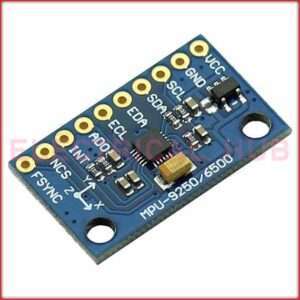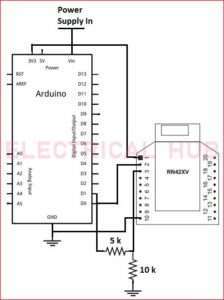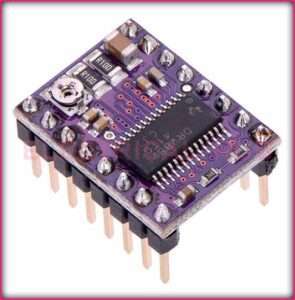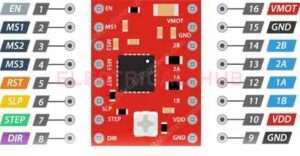MPU-9250: Important Features, Pinout, and Arduino Code
The MPU-9250 is a sophisticated sensor that operates by combining three fundamental components. Which includes a gyroscope, accelerometer, and magnetometer, in a single integrated unit. This sensor is designed to provide detailed information about the motion, orientation, and magnetic field surrounding an object.
Read More About

Working of MPU-9250
Let’s delve into how the MPU-9250 works:
Gyroscope (Measuring Rotation):
The gyroscope within the MPU-9250 works on the principle of measuring the Coriolis effect. When the sensor experiences rotation, the Coriolis force causes a displacement in a vibrating element. This displacement is then converted into an electrical signal, allowing the sensor to precisely measure the rate and direction of rotation around different axes.
Accelerometer (Measuring Acceleration):
The accelerometer is tasked with gauging changes in velocity or acceleration along multiple axes. Inside the 9250, tiny, precisely calibrated structures experience the effects of acceleration. These structures generate electrical signals corresponding to the forces acting on them, providing data on the sensor’s movement in various directions.
Magnetometer (Measuring Magnetic Fields):
The magnetometer relies on the principles of magnetoresistance to detect changes in the surrounding magnetic field. As the sensor rotates or moves, it can sense the Earth’s magnetic field and provide information about the direction and strength of the magnetic force. This is crucial for determining the sensor’s orientation relative to the Earth’s magnetic field.
Sensor Fusion and Calibration:
The magic of the MPU-9250 lies in its ability to fuse data from these three sensors to create a more accurate and comprehensive understanding of an object’s motion and orientation. Sophisticated algorithms within the sensor combine the raw data from the gyroscope, accelerometer, and magnetometer, compensating for each sensor’s strengths and weaknesses.
Calibration is a crucial step in ensuring the accuracy of the sensor’s readings. During calibration, the 9250 is subjected to known conditions, allowing it to adjust its internal parameters. This process helps mitigate environmental influences and sensor imperfections, ensuring reliable and precise data output.
Communication with Microcontrollers:
The MPU-9250 communicates with external devices, such as microcontrollers (e.g., Arduino or Raspberry Pi), using the I2C (Inter-Integrated Circuit) protocol. This enables seamless data exchange between the sensor and the microcontroller, facilitating real-time processing and decision-making based on the motion and orientation data provided by the MPU-9250.
In essence, the MPU-9250 operates as a sophisticated motion processing unit, continuously capturing, processing, and delivering accurate information about an object’s movement and orientation in three-dimensional space. Its seamless integration of gyroscopic, accelerometer, and magnetometer data makes it a powerful tool for applications ranging from robotics and drones to virtual reality and navigation systems.
Technical Specifications of MPU-9250
The MPU-9250 is a highly capable Inertial Measurement Unit (IMU) that integrates a gyroscope, accelerometer, and magnetometer into a single chip. Here are the technical specifications explained in a more human-friendly style:
Gyroscope:
Angular Velocity Range: It can measure how fast something is rotating in three different directions—X, Y, and Z axes. You can think of it as the sensor’s ability to sense rotation, whether it’s a gentle turn or a rapid spin.
Accelerometer:
Acceleration Range: This sensor can detect changes in speed or direction along the X, Y, and Z axes. It’s like a super-sensitive gravity detector that tells us how fast an object is speeding up, slowing down, or changing direction.
Magnetometer:
Magnetic Field Range: The magnetometer allows the sensor to sense the Earth’s magnetic field, giving information about the sensor’s orientation concerning the Earth’s magnetic north. It’s like a tiny built-in compass.
Digital Motion Processor (DMP):
Integrated DMP: The Digital Motion Processor is like the brain of the MPU-9250. It processes the data from the gyroscope, accelerometer, and magnetometer, combining them to provide a more accurate and comprehensive understanding of an object’s motion and orientation.
Communication Interface:
I2C (Inter-Integrated Circuit): The sensor communicates with other devices, like microcontrollers (e.g., Arduino), using the I2C protocol. This is a standardized method for electronic components to share data, making it easy to integrate into various projects.
Sampling Rate:
Configurable Sampling Rate: You can adjust how frequently the sensor takes measurements. This flexibility is useful depending on the requirements of your application, balancing accuracy and power consumption.
Voltage Range:
VDD Voltage: The sensor typically operates within a voltage range of 2.4V to 3.6V. It’s important to power it within this specified range for optimal performance.
Power Consumption:
Low Power Consumption: Designed to be energy-efficient, making it suitable for battery-powered applications where minimizing power consumption is crucial.
Resolution:
Gyroscope and Accelerometer Resolution: The sensor provides precise measurements with a high level of detail due to its 16-bit resolution.
Package Type:
Compact Package: The 9250 comes in a small package, making it suitable for integration into a variety of electronic devices without taking up much space.
Pins Configuration of MPU-9250
The MPU-9250 has a total of 24 pins, and its pin configuration is as follows:
- VDD (Power): Power supply voltage (2.4V to 3.6V).
- GND (Ground): Ground reference.
- FS0, FS1 (Gyroscope Full-Scale Select): Configurable pins for setting the gyroscope full-scale range.
- AUX_DA, AUX_CL (Auxiliary Digital I/O): Auxiliary Digital Input/Output pins.
- I2C_MST_BYPASS (I2C Master Mode Bypass): Configures the behavior of the I2C master mode.
- N/C (No Connection): Not connected.
- XDA, XCL (Auxiliary I2C Bus): Auxiliary I2C bus pins.
- SDO/AD0 (I2C Address Select): I2C address select pin.
- INT (Interrupt): Interrupt output pin.
- N/C (No Connection): Not connected.
- N/C (No Connection): Not connected.
- N/C (No Connection): Not connected.
- N/C (No Connection): Not connected.
- N/C (No Connection): Not connected.
- N/C (No Connection): Not connected.
- VDD (Power): Power supply voltage (2.4V to 3.6V).
- INT (Interrupt): Interrupt output pin.
- N/C (No Connection): Not connected.
- XCL (Auxiliary I2C Bus): Auxiliary I2C bus clock pin.
- XDA (Auxiliary I2C Bus): Auxiliary I2C bus data pin.
- AD0 (I2C Address Select): I2C address select pin.
- SDO (Serial Data Output): Serial Data Output pin.
- SDA (I2C Data): I2C data pin.
- SCL (I2C Clock): I2C clock pin.
Note: AD0/SDO pin is used for selecting the I2C address. Connecting it to VDD or GND determines the I2C address of the MPU-9250.
Equivalents of MPU-9250
The MPU-9250 is a popular Inertial Measurement Unit (IMU) with a combination of gyroscope, accelerometer, and magnetometer sensors. There are several equivalents or alternative sensors available in the market that serve similar purposes. Here are a few alternatives:
MPU-6050:
The MPU-6050 is an earlier version of the MPU sensor series. It includes a 3-axis gyroscope and a 3-axis accelerometer but lacks the magnetometer. It is suitable for applications that don’t require magnetic field measurements.
MPU-6500:
The MPU-6500 is another variant in the MPU series. It combines a 3-axis gyroscope and a 3-axis accelerometer. Like the MPU-6050, it does not include a magnetometer.
MPU-9255:
The MPU-9255 is similar to the MPU-9250 but may have some differences in features and specifications. It includes a 3-axis gyroscope, a 3-axis accelerometer, and a 3-axis magnetometer.
BNO055:
The BNO055 from Bosch Sensortec is a 9-DOF sensor that integrates a 3-axis accelerometer, 3-axis gyroscope, and a 3-axis magnetometer. It also includes a dedicated microcontroller for sensor fusion, providing quaternion and Euler angle outputs.
LSM9DS1:
The LSM9DS1 from STMicroelectronics is a 9-DOF sensor with a 3-axis accelerometer, 3-axis gyroscope, and 3-axis magnetometer. It is designed for applications requiring accurate motion sensing.
MPU-9255:
The MPU-9255 is similar to the MPU-9250 and provides 9 degrees of freedom with a 3-axis gyroscope, 3-axis accelerometer, and 3-axis magnetometer.
FXOS8700/FXAS21002:
The FXOS8700 and FXAS21002 are sensors from NXP Semiconductors. The FXOS8700 is a 3-axis accelerometer and 3-axis magnetometer, while the FXAS21002 is a standalone gyroscope. When combined, they offer 9 degrees of freedom.
mPU 9250 eSP32
To use the MPU-9250 with an ESP32 microcontroller, you’ll need to connect the sensor to the ESP32 using the I2C interface. Here’s a basic guide on how to connect and read data from the MPU-9250 using an ESP32:
Wiring:
- Connect the MPU-9250 to the ESP32 as follows:
- VDD of 9250 to 3.3V on ESP32
- GND of MPU-9250 to GND on ESP32
- SDA of 9250 to SDA (GPIO21) on ESP32
- SCL of MPU-9250 to SCL (GPIO22) on ESP32
- AD0 of 9250 to GND (or leave unconnected for default address)
Libraries:
You will need the necessary libraries to interface with the MPU-9250. Install the following libraries using the Arduino Library Manager:
Wire Library: This is a standard library for I2C communication.
Adafruit MPU9250 Library: This library provides functions to communicate with the 9250 sensor.
Example Code:
Here’s a simple example code to get you started. Make sure to include the necessary libraries at the beginning of your Arduino sketch:
#include <Wire.h>
#include <Adafruit_Sensor.h>
#include <Adafruit_MPU9250.h>
#include <Adafruit_MPU9250_U.h>
Adafruit_MPU9250 mpu;
void setup() {
Serial.begin(115200);
Wire.begin();
if (!mpu.begin()) {
Serial.println("Failed to find MPU-9250 sensor!");
while (1);
}
Serial.println("MPU-9250 Found!");
}
void loop() {
sensors_event_t a, g, temp;
mpu.getEvent(&a, &g, &temp);
Serial.print("Acceleration: ");
Serial.print(a.acceleration.x);
Serial.print(", ");
Serial.print(a.acceleration.y);
Serial.print(", ");
Serial.println(a.acceleration.z);
Serial.print("Gyro: ");
Serial.print(g.gyro.x);
Serial.print(", ");
Serial.print(g.gyro.y);
Serial.print(", ");
Serial.println(g.gyro.z);
delay(1000);
}This code initializes the MPU-9250 sensor and continuously reads and prints accelerometer and gyroscope data to the Serial Monitor. Adjust the connections based on your wiring and make sure to select the correct I2C pins on your ESP32.
mPU 9250 Arduino code
To work with the MPU-9250 sensor using Arduino, you’ll need to use a library that supports this sensor. One popular library is the “MPU9250” library.

Below is a simple example code to get you started. Ensure that you have the “MPU9250” library installed in your Arduino IDE before uploading the code to your Arduino board.
#include <Wire.h>
#include <MPU9250.h>
MPU9250 mpu;
void setup() {
Serial.begin(115200);
Wire.begin();
if (!mpu.begin()) {
Serial.println("Failed to initialize MPU-9250. Please check wiring.");
while (1);
}
Serial.println("MPU-9250 initialized successfully!");
Serial.println("Calibrating gyro and accelerometer. Please keep the device stationary...");
mpu.calibrateGyroAccel();
Serial.println("Calibration complete!");
}
void loop() {
mpu.update();
Serial.print("Acceleration: ");
Serial.print(mpu.getAccelX_mss());
Serial.print(", ");
Serial.print(mpu.getAccelY_mss());
Serial.print(", ");
Serial.print(mpu.getAccelZ_mss());
Serial.println(" m/s^2");
Serial.print("Gyroscope: ");
Serial.print(mpu.getGyroX_rads());
Serial.print(", ");
Serial.print(mpu.getGyroY_rads());
Serial.print(", ");
Serial.print(mpu.getGyroZ_rads());
Serial.println(" rad/s");
Serial.print("Magnetometer: ");
Serial.print(mpu.getMagX_uT());
Serial.print(", ");
Serial.print(mpu.getMagY_uT());
Serial.print(", ");
Serial.print(mpu.getMagZ_uT());
Serial.println(" uT");
Serial.println();
delay(1000);
}This code reads accelerometer, gyroscope, and magnetometer data from the MPU-9250 and prints it to the Serial Monitor. Before uploading the code, make sure you have the “MPU9250” library installed. You can install it through the Arduino Library Manager.
This example also includes a calibration step for the gyroscope and accelerometer, which is crucial for accurate readings. During the calibration, keep the sensor stationary to allow it to establish baseline values. After calibration, you can proceed to read the sensor data in real-time.
Remember to connect the SDA and SCL pins of the MPU-9250 to the corresponding pins on your Arduino board. Also, power the MPU-9250 with the appropriate voltage (3.3V) and connect the ground (GND) pin.
Applications Of MPU-9250
The MPU-9250, with its combination of gyroscope, accelerometer, and magnetometer, finds applications in various fields due to its ability to provide accurate motion and orientation data. Some common applications include:
Motion Sensing in Consumer Electronics:
Used in smartphones, tablets, and wearable devices to enable features such as screen orientation adjustments, step counting, and gesture recognition.
Virtual Reality (VR) and Augmented Reality (AR):
Essential for tracking head movements and providing a more immersive experience in VR and AR applications.
Gaming Controllers:
Integrated into gaming controllers to capture and respond to users’ movements for enhanced gaming experiences.
Robotics:
Employed in robotics for precise control of robot movements, stabilization, and navigation.
Drones and UAVs (Unmanned Aerial Vehicles):
Used for stabilizing flight, controlling attitude, and providing accurate navigation data for drones and UAVs.
Inertial Navigation Systems:
Integrated into navigation systems for aircraft, ships, and vehicles to provide accurate heading, pitch, and roll information.
Health and Fitness Tracking:
Incorporated into fitness trackers and health monitoring devices to measure physical activity, posture, and motion.
IoT (Internet of Things) Devices:
Applied in various IoT applications for monitoring and controlling devices based on motion and orientation data.
Biomechanics and Sports Science:
Utilized in sports science to analyze athletes’ movements and biomechanics for performance optimization and injury prevention.
Smart Helmets and Head-Mounted Displays:
Integrated into smart helmets and head-mounted displays for applications like augmented reality in industrial settings.
Gesture Recognition Systems:
Used to recognize and interpret gestures in human-computer interaction systems.
Navigation and Positioning Systems:
Incorporated into devices for accurate positioning and navigation, especially in combination with other sensors like GPS.
Educational Robotics:
Applied in educational robotics to teach students about sensor integration and motion control.
Automotive Industry:
Integrated into advanced driver-assistance systems (ADAS) for features like vehicle stabilization, collision avoidance, and lane-keeping assistance.
Industrial Automation:
Used in industrial automation for monitoring and controlling the motion of machinery and equipment.
What is the MPU-9250?
The MPU-9250 is an Inertial Measurement Unit (IMU) that combines a 3-axis gyroscope, a 3-axis accelerometer, and a 3-axis magnetometer in a single chip. It is designed to provide accurate motion and orientation data.
How does the MPU-9250 communicate with a microcontroller?
The MPU-9250 typically communicates with a microcontroller using the I2C (Inter-Integrated Circuit) communication protocol. Some variants may also support other communication interfaces.
What is the purpose of the gyroscope in the MPU-9250?
The gyroscope measures the rate of rotation around its axes, providing information about the angular velocity of an object. This is crucial for understanding the object’s movement and changes in orientation.
Can the MPU-9250 be used with Arduino?
Yes, the MPU-9250 is commonly used with Arduino. There are libraries available that simplify communication and data retrieval, making it accessible for Arduino projects.
What are the applications of the MPU-9250?
The MPU-9250 finds applications in various fields, including robotics, drones, virtual reality, gaming controllers, health and fitness tracking, navigation systems, and industrial automation, among others.
How is calibration performed for the MPU-9250?
Calibration involves establishing baseline values for the gyroscope and accelerometer to improve accuracy. During calibration, the sensor should be kept stationary in known conditions. Some libraries may provide functions for automatic calibration.
What is the difference between the MPU-9250 and MPU-6050?
The MPU-9250 includes a magnetometer (compass) in addition to the gyroscope and accelerometer, providing 9 Degrees of Freedom (DOF). The MPU-6050, on the other hand, lacks the magnetometer, offering 6 DOF.
Can the MPU-9250 be used for navigation?
Yes, the MPU-9250 is used in navigation systems, especially when combined with other sensors like GPS. It provides accurate motion and orientation data, contributing to precise positioning.
What is the power supply voltage for the MPU-9250?
The MPU-9250 typically operates with a supply voltage in the range of 2.4V to 3.6V.
Does the MPU-9250 have a temperature sensor?
The MPU-9250 includes an onboard temperature sensor that provides information about the ambient temperature.
Worth Read Posts
Subscribe to our Newsletter “Electrical Insights Daily” to get the latest updates in Electrical Engineering. You can also Follow us on LinkedIn and Facebook to see our latest posts on Electrical Engineering Topics.





